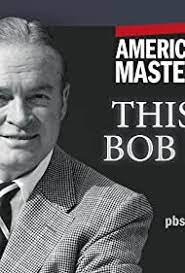
THIS IS BOB HOPE
US, 2017, 90 minutes, Colour.
Directed by John Scheinfeld.
Bob Hope died at the age of 100 in 2003. For most of those hundred years he was an entertainer, becoming a celebrity in his 20s and continuing that until the end of the 20th century. For many decades, radio and television and movie audiences not only knew who he was but liked him, enjoyed his entertainment.
Hope was born in England but his parents migrated to the US, to Cleveland, when he was four. He began his entertainment career in vaudeville, stage performances, comedy, expert dancing, learning how to appreciate his audience, working his audience, developing his timing. He then moved into radio in the 1930s, and in 1950 he moved to television, specialising in comic monologues, but also entertainment, some of it improvised, all live on television.
He had met Bing Crosby in the 30s and renewed acquaintance when he went to Hollywood to begin a film career. Paramount executives enjoyed their working together and thought they should appear on film – the beginning of the Road to movies, lots of in jokes, talking to camera, and putting each other down. But, Hope appeared in a number of comedies and established his signature song and melody, Thanks for the Memories. And, in 1940, he began 17 years of compering the Oscars, often making jokes about his never winning.
Don’t words from his memoirs are voiced here by Billy Crystal (who is seen paying tribute to Bob Hope at a later Oscars).
This film is most entertaining with so many clips from Bob Hope’s films, establishing his screen persona, fearful, sometimes timid in romance, lots of comedy, and sometimes, as with James Cagney in The Seven Little Foys, the flare for tap dancing.
One of the significant contributions of Bob Hope to entertainment was his travelling to Europe and throughout the Pacific during World War II, identifying with the troops, entertaining them. And this was to continue during peace times, during the Korean War, and into the Vietnam war – where, Bob Hope seemed to identify with the more hawkish tone, including conversations with Richard Nixon, which led to his being identified with the establishment and, in Vietnam, actually booed (with Connie Stevens reminiscing about how she was advised to sing something, began Silent Night and all the troops joined in).
There are many talking heads throughout this film (including Kermit the frog!). There are quite a number of screenwriters for Hope who reminisce about their working together, the kinds of jokes, his collaborating with them. There are also quite a number of excerpts from Woody Allen, offering insight into Hope’s method, screen presence, delivery and the influence on Allen himself in performance and writing. Other stars include Brooke shields and Tom Selleck. Also comments by Dick Cavett.
There is quite a lot of comment about his gregarious personality, his enjoyment in meeting people, signing autographs, coming alive when he went on stage, the rapport with his audience. There is a lot of comment also about how difficult it was to know the interior of Hope’s. His daughter Linda is a contributor to the comments, praise of Dolores Hope for her fidelity to her husband in 69 years of marriage while he had a reputation for extreme philandering. The Hopes adopted four children. There are photos and sequences illustrating his role as a father, though often absent (but always sending postcards to them).
This is a very entertaining documentary, immersing the audience in the personality and comedy of Bob Hope – but also insightful about his personality and relationships, his personal weaknesses in relationships, but acknowledging the joy and happiness he brought to so many people over such a long time.